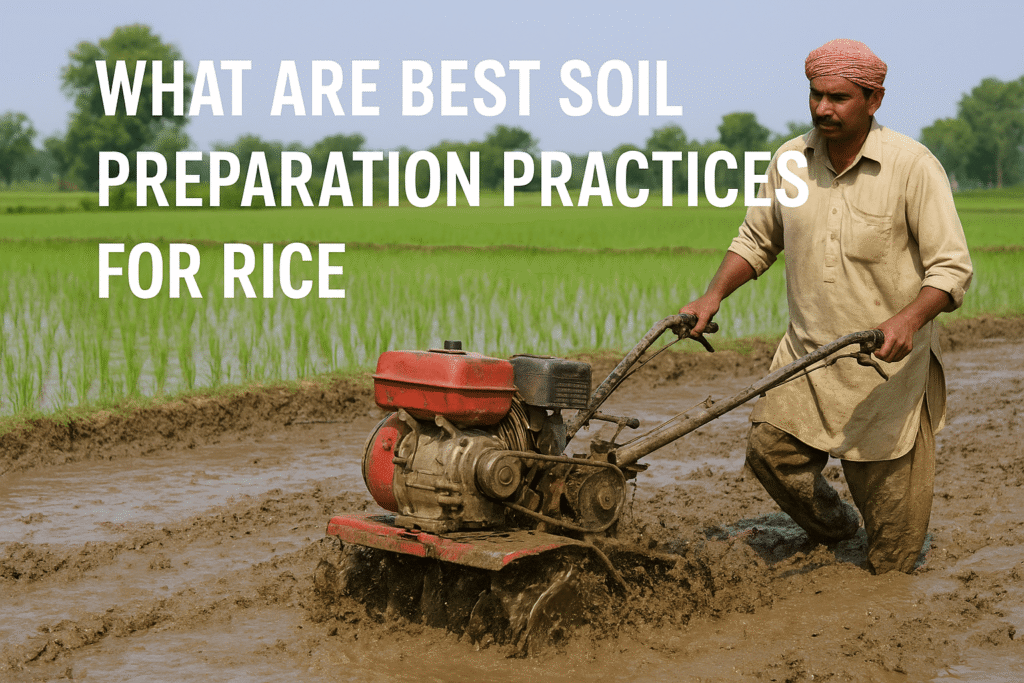
Rice is one of the most important food crops in Pakistan, feeding millions of people daily and providing income for farmers across Punjab, Sindh, and Khyber Pakhtunkhwa. But the success of any rice crop starts long before sowing — it begins with proper soil.
In simple words, good soil preparation = healthy plants = higher yield.
Let’s explore what are best soil preparation practices for rice, their impact on yield, the common mistakes farmers make, and some technical recommendations to improve production.
Table of Contents
ToggleWhy Soil Preparation Matters for Rice in Pakistan
Soil preparation is like preparing a bed for a baby — if it’s comfortable and clean, the plant will grow healthy and strong. Rice, being a semi-aquatic crop, needs special soil conditions to grow well:
Soft and puddled soil helps roots establish quickly.
Level land ensures uniform water distribution.
Proper tillage breaks compact layers and improves nutrient absorption.
Research from agricultural universities in Pakistan shows that farmers who prepare soil properly get 10–20% higher yields compared to those who skip or rush the process.
Step by Step Soil Preparation Guide for Rice
1. Choose the Right Time for Preparation
Kharif season rice in Pakistan is usually sown between May and July.
Start land preparation 2–3 weeks before transplanting or sowing.
Early preparation allows weeds to germinate and be destroyed before planting.
Tip: In Sindh, early preparation also helps conserve water before canal closures.
2. First Tillage (Primary Cultivation)
Use a disc plough (Local name: Diski Hal) or mouldboard plough (Local name: Hal) to break the soil.
Depth: 6–8 inches for clay soils, 8–10 inches for sandy loams.
This helps in breaking the hardpan and burying weeds.
Local Insight: In Punjab, farmers often use a chisel plough for deep tillage before rice to improve water penetration.
3. Puddling for Rice
Puddling is the process of ploughing flooded soil to make a soft, muddy layer that holds water.
Flood the field with 3–4 inches of water.
Use a rotavator (Local: Rotavator Machine) or puddler to mix soil and water.
Repeat 2–3 times to achieve a uniform muddy surface.
Benefits of Puddling:
Reduces water loss by percolation.
Helps in easy transplanting.
Controls weeds naturally.
4. Land Leveling
Uneven fields cause water logging in some parts and dryness in others.
Use a laser land leveler for perfect leveling.
Level fields ensure uniform crop growth and save 20–25% irrigation water.
5. Fertility and Organic Matter
Before final puddling, apply well-rotted farmyard manure (Local: Kacha Gobar) — about 8–10 tonnes per acre.
This improves soil structure and increases nutrient availability.
Also, test soil every 2–3 years and apply recommended doses of DAP, urea, and potash.
6. Pre-Plant Weed Control
Allow weeds to germinate after the first ploughing, then destroy them in puddling.
For fields with stubborn weeds like Dila (Echinochloa), use pre-emergence herbicides as per International Rice Research Institute guidelines.
Impact of Soil Preparation on Rice Yield
Farmers who follow what are best soil preparation practices for rice enjoy several benefits:
| Factor | Without Proper Preparation | With Proper Preparation |
|---|---|---|
| Yield | 30–35 maunds/acre | 40–50 maunds/acre |
| Water Use | 20–30% more | Optimized |
| Weed Pressure | High | Low |
| Fertilizer Efficiency | Low | High |
Example:
A farmer in Hafizabad followed laser leveling, puddling, and timely tillage. His Super Basmati yield increased from 38 maunds/acre to 48 maunds/acre in one season without increasing fertilizer cost.
Common Mistakes Farmers Make in Rice Soil Preparation
Skipping Land Leveling – Uneven water distribution leads to patchy crop.
Late Preparation – Delays sowing, reduces tillering, and shortens crop duration.
Over Tillage – Excess passes waste fuel and destroy soil structure.
Ignoring Organic Matter – Leads to hard soil and low nutrient holding.
Not Controlling Weeds Early – Increases herbicide cost later.
Technical Recommendations for Rice Farmers in Pakistan
Follow the 3-Pass Rule: One deep plough, one puddling, and one leveling for efficiency.
Incorporate Green Manure: Crops like Sesbania improve nitrogen levels.
Check Irrigation Water: Salty water can reduce germination and growth.
Use Certified Seed: Good soil preparation works best with healthy seed.
Rotate Crops: Avoid rice-on-rice for many years to prevent soil degradation.
Farmer-Friendly Summary
What are best soil preparation practices for rice?
In Pakistan’s conditions, the key steps are:
Timely primary tillage with a disc or mouldboard plough.
Proper puddling in 3–4 inches of water.
Laser land leveling for uniform growth.
Addition of farmyard manure and balanced fertilizers.
Early weed control before transplanting.
These steps help in conserving water, improving fertilizer efficiency, and boosting yields by up to 15–20%.
Conclusion
For Pakistani farmers, proper soil preparation for rice is not just a technical step — it’s the foundation of the entire crop. By understanding what are best soil preparation practices for rice and avoiding common mistakes, farmers can achieve higher yields, save water, and reduce input costs.
Remember, healthy soil means a healthy crop, and a healthy crop means a healthy income.